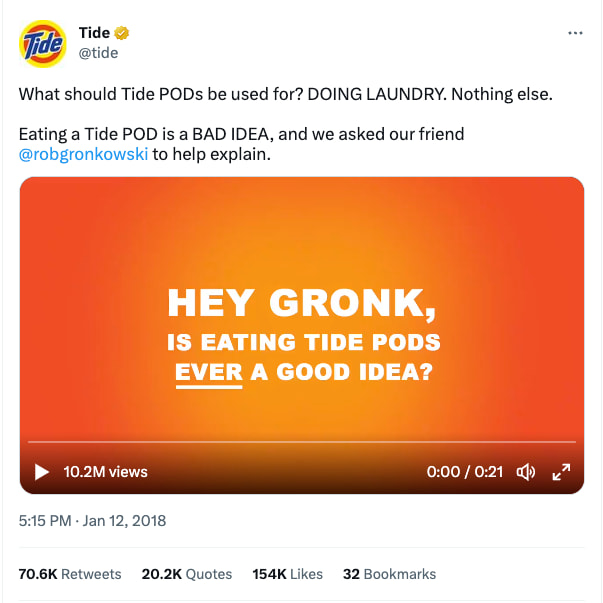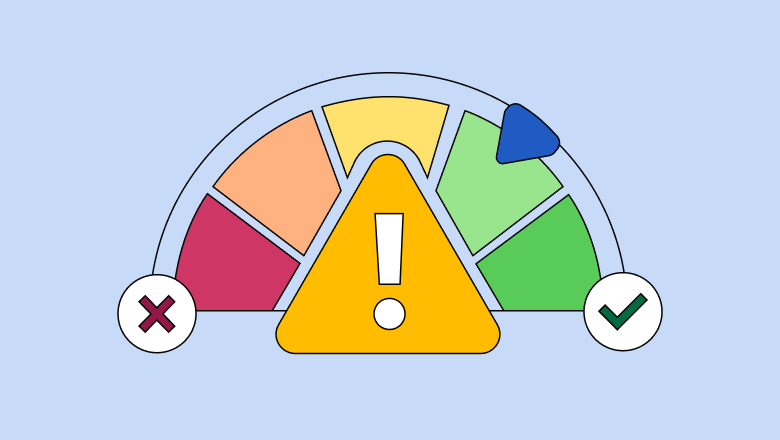
Crisis Communications
Crisis communications: What it is and examples brands can learn from
Want to protect your brand reputation during a crisis? This article dives into successful real-life examples of crisis communication with key takeaways to fortify your communication strategy.
Reading time 13 minutes
Published on December 5, 2024

Table of Contents
Summary
- Being ready for negativity is crucial in today's fast-paced market. A crisis communication plan is key to effectively respond to negative publicity and minimize brand damage.
- Brands such as Slack, Aldi, Carrefour, KFC and Tide have navigated crises brilliantly. These champions are exceptional examples of building effective communication strategies.
- Brands can transform potential disasters into opportunities to strengthen their communication and connect with audiences in meaningful ways.
Imagine waking up on a Monday morning to discover a social media firestorm about your brand. A single tweet has gone viral, and customers are furious. How will you respond?
In today’s digital age, social media is often the ground zero for brand crises. A well-crafted crisis communication plan, especially for social media, is essential for weathering any storm. It’s like an insurance policy—you hope you never need it, but you’re grateful to have it when disaster strikes.
Today’s marketing teams are juggling multiple channels, executing integrated plans and navigating a world of constant change. Yet, many brands aren’t prepared for a crisis.
In a survey conducted by Edelman, one in four executives say their organization is unprepared to face any sort of crisis. That number climbs to one in three regarding social and geopolitical issues.
Your brand’s best bet is to avoid any future problems by creating and testing a comprehensive crisis management plan that includes robust guidance around communication.
What is crisis communications?
Crisis communications is a method of sharing information intended to improve public brand perception in the face of a scandal or other negative event.
Crisis communications is a critical component of an effective crisis management strategy. It typically involves multiple internal teams (corporate communications, public relations, social media and legal) collaborating across various channels, including the business’ social, web and email properties.
Effective crisis communication can be the difference between a temporary setback and a lasting brand tarnish, and a strong crisis communication and brand safety strategy is your first line of defense.
The importance of strong crisis communication
Almost every established business will face a crisis at some point. The ability to recover from a crisis often hinges on the strength and clarity of a brand’s communication with stakeholders. In fact, 41% of consumers say they would return to a brand that apologizes and admits its own wrongdoing.
Effective crisis communication can be the difference between a temporary setback and a lasting brand tarnish. If (and, more likely, when) a breach of customer trust occurs, it’s critical to address it appropriately. Brands that implement a quality crisis communication plan can avoid long-term impacts to stock prices (for public companies), declines in sales and negative impact on both employee and customer attrition.
The role of social media in crisis communication
Social media plays a dual role in crisis communication, both a potential catalyst for crises and a critical avenue for managing them.
A single negative comment or insensitive post can quickly spiral into a full-blown PR disaster as it’s shared and amplified across networks. Social media negativity can boom within hours, growing from a few comments to thousands seemingly in the blink of an eye. News outlets often pick up on trending social media events, further increasing the reach of the situation to new audiences and markets.
On the flip side, social platforms are a brand’s first line of defense when responding to a crisis. Notes app apologies have become a PR mainstay. Monitoring your brand mentions with social media listening tools and responding quickly and transparently can help you manage and turn around negative sentiment just as quickly as it started. The same factors that make social media a powerhouse for creating a crisis can work in your favor for containing it.
Using your brand accounts to keep followers updated on the situation is important for transparency. If the situation calls for an apology and repair, your social media accounts are critical to reaching your audience.
To stay ahead of the curve, consider using social media management and listening tools, like Sprout Social. Here are some of the specific ways Sprout can help.
- Build Listening topics to stay dialed in on important conversations: AI-driven social listening capabilities can enhance your crisis management plan by keeping you informed about conversations happening around your brand. You can design specific listening queries around conversations you want to track. And with Listening, you can understand audience sentiment around specific topics for a better picture of what’s driving negative conversations.
- Use Listening Spike Alerts to track surges in conversation about your brand: These alerts give a heads up when messages or comments are suddenly increasing, sometimes a sign that a crisis is growing. Customize individual Spike Alerts by adjusting sensitivity levels and the specific metrics you want to monitor.
- Get Listening insights faster with Analyze by AI Assist: Sprout Social can also assist in navigating a crisis by analyzing your listening queries and alerts and extracting key insights in real time. Analyze by AI Assist shows you significant metrics, hashtags, keywords, Smart Categories and emojis. These in-the-moment insights will keep you ahead of the curve and will support your ability to execute a crisis management plan.
What is a crisis management plan?
A crisis management plan is an actionable communication strategy meant to protect a brand’s reputation during a negative event. It includes processes to identify a crisis and the communication procedures for responding.
A good plan explains different types of crises and how to handle each. Regularly review and update your plan to reflect changes in your brand, industry and social media landscape.
How to write a crisis communications plan (with a template)
Developing a crisis communications plan requires in-depth brainstorming and collaborating; make sure to set aside the necessary time for the process. Your upfront dedication will pay off when you need it most.
To help you get started, we’ve put together a step-by-step guide to crafting a great crisis communication strategy. You can even download our comprehensive crisis communication template to safeguard your brand’s future.
CTA BUTTON: Get the template
Form a crisis management team
A crisis requires all hands on deck, and developing your communications plan is no different. Collaboration outside the marketing and social media teams is critical. First, assign key roles like a team leader who’ll oversee the development of the plan and a coordinator who’ll project manage and liaise with stakeholders in other departments.
Next, bring in experts from other areas of your organization:
- Legal: From understanding regulations to managing liability in your response strategy, you’ll work closely with your organization’s legal team during a crisis.
- Social media: Be sure to include someone with specific social media expertise. This might be someone in the marketing department or from your social media content team.
- IT/cybersecurity: This team can help you understand some of the digital risks that lead to a crisis and will be in charge of investigating any cybersecurity events that occur.
- Human resources: HR leaders can offer valuable insight about how a crisis could affect employees and can assist in developing communications for your internal audiences.
- Operations: A crisis can impact the day-to-day functions of your organization, and the operations team can help you develop a plan for any adjustments that will be needed.
Define crisis management team roles and duties
With your team members in place, it’s time to lay out roles and duties. In addition to the team leader and coordinator positions, you can divide up responsibilities in research, stakeholder interviews and the creation of the final deliverable.
Your crisis communications approach will also need clearly defined point persons for tasks during an actual event. Spokespersons and content approvers should be decided beforehand to ensure you can implement your plan fast when needed.
Conduct a SWOT analysis
Conducting a SWOT analysis is a chance to get a holistic picture of your brand’s current situation to better understand both what you’re doing well and how to improve.
Example: your brand may have a strong customer service program on social media (strength), but lack the ability to respond to internal complaints and issues (weakness).
Competitors recently poaching your customers could be a threat, while bringing in an outside agency to media train your executive team is an opportunity.
Set up communication procedures and guidelines
Now it’s time to get into the meat of your crisis approach: The actual procedures you’ll follow when something happens. As you develop these guidelines, consider who needs to be involved, timelines and how you’ll adapt if needed. Things to include:
- How soon you’ll respond and what specific channels
- How to handle pre-scheduled content on social (for instance, will you pause publishing?)
- How you’ll communicate internally
- Distribution of press releases and media relations
- How to notify customers via email, particularly if a crisis will impact your ability to fulfill products or services
- Designated social media responders trained on your crisis plan
- When the chosen spokesperson will be deployed and on what channels
- Preferred frequency of social media posting during a crisis
- Pre-approved crisis messages for social channels
- Comment moderation and response protocols (like a clear escalation process for negative comments)
- A social media monitoring strategy
- A timeline for when regular content (advertising, social, email, etc.) can resume
Brainstorm crisis examples
Crisis communications isn’t one-size fits all, and your approach may differ by channel. And it will certainly differ depending on the type of crisis you experience.
For example, you may experience a crisis spurred from a negative post on Facebook that doesn’t really reach your TikTok audience, so your strategy may specifically target your Facebook audience. However, if you’re dealing with a crisis related to a sensitive global issue, you may take a broad approach to messaging but customize response protocols by channel.
Spend time brainstorming crises your brand may face. Looking to past events both your brand and competitors have experienced is a good starting point.
Don’t be afraid to think worst-case scenario; better to be prepared than caught unaware. Spend time considering events that may happen on social media or be amplified on these channels. Examples could include a negative influencer review on Instagram about one of your products; a product safety scare sparked by a customer’s post on Facebook; or a customer live-tweeting a poor service experience at one of your brick and mortar locations.
Draft responses
Once you have potential crises sketched out, develop responses you can easily apply for each scenario. These should be adaptable for different channels but help you keep the same tone of voice and messaging across the board.
Draft responses you can keep in a response bank and then apply to press releases, social posts, comment responses and more. Consistency is key, but remember to stay adaptable in the moment.
Train team members
With your carefully developed plan in hand, it’s time to train necessary team members in your approach. Ensure everyone is well-versed in what the plan includes, and run mock scenarios to get practice in responding and deploying the procedures.
This is also a good time to make sure team members are knowledgeable about the crisis management tools at their disposal. Cover the chain of command, who has what type of access to these tools and how to notify the appropriate team if an employee is contacted by the media or a customer about the crisis.
If needed, consider bringing in outside experts to provide media training for your team. This can help your spokesperson(s) learn to effectively communicate with the media during a crisis and keep a level head during interviews or press conferences.
Crisis communication examples
The last several years have seen brands grappling with a number of external crises outside of their control (the COVID-19 pandemic, social unrest, geopolitical tensions, etc.). Yet, many brands have also dealt with the effects of missteps within their own companies—which, in many cases, can be even worse.
We’ve all seen the headlines about brand scandals and businesses’ attempts to reclaim their reputations. In some cases, these stories even tell tales of ill-conceived crisis communication strategies that failed to improve the situation or even exacerbated it.
While there are certainly lessons to learn from these public relations debacles, there’s perhaps even more to take away from successful responses. Below, we’re sharing some relevant crisis communication examples from the last five years and offering key takeaways for brands.
Slack’s response to an outage (2022)
In February 2022, a widespread outage occurred at Slack, an online messaging application, during which many users were unable to access the platform. The problem was eventually traced back to a configuration change, which caused a sudden increase in activity on the company’s database infrastructure.
On its status page, Slack posted regular updates throughout the five-hour event to keep users informed about their progress toward a solution and even calling out missteps they made in the process.
These messages, posted about twice an hour, transparently detailed the company’s efforts to restore full access to all users. They also used X (formerly known as Twitter) to communicate with users in a tone that was authentic yet apologetic (see below).
Key takeaways for your crisis strategy:
- Be as honest, transparent and accessible as possible. If your organization made a mistake, own it and be available for questions and feedback.
- Communicate effectively on the platforms your audience is most likely to see your message. Include social media alongside a mix of other channels like email or even a more traditional media outlet; ensure that the message gets to as many customers as quickly as possible.
- Audiences appreciate vulnerability. Show your audience there are real people behind your brand who are willing to be honest and empathize with customers.

Aldi’s hairy caterpillar predicament (2021)
Aldi, a German grocery store chain, committed a faux pas when they allegedly infringed on a trademark owned by rival grocery store Marks & Spencer (M&S)—related to its Colin the Caterpillar Cake. It turns out Aldi had launched a suspiciously similar product, named Cuthbert, in the previous months.
Aldi launched a cadre of posts using the new hashtag #FreeCuthbert, which trended at number one on X within hours.
Fans of the brand (and of the snack) rallied around Aldi, resharing its messages and voicing their support. Views of user-generated videos topped out at over 30 million. In the end, M&S and Aldi settled the conflict and Cuthbert remained on the shelves.
Key takeaways for your crisis strategy:
- In the right circumstance, humor can be useful. If a crisis isn’t “life or death,” adding some levity to your responses can resonate with audiences. However, if your brand voice is typically more buttoned-up and hasn’t employed humor before, a crisis isn’t the time to experiment.
- Amplify support from your brand loyalists by re-sharing their positive content about the crisis or deploy a related hashtag social media audiences can use.

Carrefour Group responds to tragedy (2020)
In late 2020, a 40-year-old Black man, João Alberto Silveira Freitas, was killed by a group of white security guards outside one of Carrefour’s Brazilian supermarket locations. Bystanders on the scene took videos of the brutal attack and posted them to social media, sparking outrage among Brazilians and other concerned citizens across the globe.
In the aftermath of the event, the local unit of Carrefour made a statement saying they were terminating their contract with the security firm as well as taking immediate legal action against them.
In addition, they also promised to review how employees and contractors were trained on security, diversity and tolerance, and also to close the store out of respect for the victim and his family.
The chairman and CEO of the company went further, saying in a Tweet, “My values, and the values of Carrefour do not allow for racism and violence.”
Key takeaways for your crisis strategy:
- Take immediate, impactful action where possible. Ensure leadership visibility while doing so and reflect your values in all crisis communications.
- Look for ways your brand can make a positive impact, even if a crisis isn’t of your own making. Use your spokesperson to reiterate brand values, and layout plans for rectifying the situation or supporting change in the future.
KFC’s UK chicken shortage (2018)
Isn’t it ironic that a fast food restaurant known almost exclusively for its fried chicken ran out of its namesake product? That’s exactly what happened in 2018 when the United Kingdom arm of KFC experienced supply chain issues that resulted in a shortage of many of its key ingredients and the closure of 900 locations.
In response, the company leaned on its irreverent brand voice to poke fun at its own misstep. KFC launched a print campaign in which their buckets were labeled “FCK” instead of “KFC” and took to X to engage with fans who were upset about temporarily missing out on their favorite meal.
With ad headlines like “The chicken crossed the road, just not to our restaurants,” KFC helped customers find the humor in the situation and effectively turned the tide of public sentiment.
KFC’s brand impression score, which dropped to -12 during the crisis, has now bounced back to a -1 (one point better than before the event).
Key takeaways for your crisis strategy:
- Don’t lose sight of your brand voice during crises. Look for opportunities to delight your audience, even when actively managing a crisis, and empathize with how the situation impacts them.
- Make sure your crisis strategy includes all channels, from social to print. Know how you’ll respond on various networks in advance, and incorporate timelines for things like print ads into your plan if needed.

Tide navigates the Tide Pod challenge (2018)
It’s hard to imagine anyone would find a Tide laundry detergent pod appetizing, but when the Tide Pod challenge kicked off on YouTube, teenagers were being sent to the hospital left and right. In 2017, more than 200 adolescents ingested a pod, and about a quarter of those cases were not accidental.
In response, Tide launched a campaign in early 2018, in partnership with football star Rob Gronkowski designed to deter this dangerous behavior. By leaning on the cache of a well-known and admired athlete, the company hoped to shift the narrative to make the Tide Pod challenge seem silly and uncool.
Key takeaways for your crisis strategy:
- When it makes sense, partner with influencers and celebrities. The right partner can both reinforce your message and amplify your response.
- Consider multimedia responses in your strategy. Static images and video are memorable, favored by social media algorithms and can often get your message across more efficiently than plain text.

Plan now to keep your cool later with a crisis communications strategy
While you hope to never need a crisis plan, your future self will thank you for having a solid approach in place. If your company doesn’t have a crisis communication plan in place, you could be caught flat-footed the next time a brand scandal pops up.
Using the template and examples above, you have the proper tools to develop your own sensible approach. If you need a social media management platform that can support your crisis preparedness and mitigation efforts, try out Sprout Social free for 30 days.
Crisis Communications FAQ
Why is it important to have a crisis communication plan?
A crisis communication plan can save time and mitigate damage to your brand’s reputation in the event of a crisis. Responding successfully to a crisis can help your organization avoid serious fallout from a negative event, including impacts on revenue, employee satisfaction, customer loyalty and public perception.
What role does social media play in your crisis response?
Social media channels have several roles in crisis communication. These networks can be both the impetus for a crisis and the main response and crisis management tool. A crisis can be born on social media from comments, consumers posting about negative experiences with a brand or a company posting insensitive, poorly timed or offensive content.
Social media is also an important avenue for crisis response and brand transparency.
How do I handle crisis communication?
When approaching crisis communications, begin by developing a comprehensive plan that addresses multiple potential scenarios. This plan should cover:
- Crisis team members and roles
- An analysis of strengths, weaknesses, opportunities and threats
- Response procedures and guidelines
- Actual response content
- How to evaluate a crisis response once it’s over
Remain flexible when responding to a crisis, and keep transparency and honesty at the forefront.
What are the 5 Cs of crisis communication?
The five C’s of crisis communication include:
- Consistency–keep your message and voice consistent across channels.
- Clarity–communicate clearly, honestly and at your audience’s level.
- Care–empathize with how a crisis affects your audience and show that you care.
- Credibility–be honest and never lie about a crisis.
- Commitment–follow through on what you say you’ll do.
Additional resources for Crisis Communications
How to create a social media crisis communication plan
The complete crisis management guide for marketing leaders
7 Best crisis management tools: A guide for marketers
Social media governance for EU businesses: 5 ways to protect your brand
Crisis communications: What it is and examples brands can learn from
What to do right now: How to navigate through a global crisis on social media
Essential Sprout features to help your brand maintain connection in an uncertain time












Share